![]()
![]()
![]()
Use LEFT and RIGHT arrow keys to navigate between flashcards;
Use UP and DOWN arrow keys to flip the card;
H to show hint;
A reads text to speech;
26 Cards in this Set
- Front
- Back
|
Romanesque
|
+Gov: Feudalism system- BARON has many acres of land and sells a section of it to a TASSEL. TASSEL will place SERFS on the land to build colonies and grow crops for harvest.
+Religion: Christianity, christ is stern, judging. +Women: not valued +Artists: traveled to different churches to spread Romanesque style. +Tried to imitate Roman architecture but failed. +Revival of commerce and manufacturing. Opened trade routes to help cities and churches flourish. +Tribune= 2nd story |
|
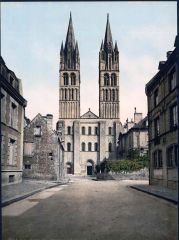
Title: Saint Etienne
Date: 1100 A.D. Style: Romanesque Artist: Unknown |
It was started by William of Normandy. He died in 1087 and was entombed in the church.
It has a WESTERN FASCADE and WESTWORK (the two towers). It has TRIPARTITE seperation of portals (doors), as well as round arch windows. The three stood for the Holy Trinity. It has 4 BUTTRESSES to support the heavy wall. It has a small nave. Towers: Tops are Gothic. First section has very slim round arches, the second section has cutouts for the bell, and the third section has round arches on columns and cutouts. Inside: Super dark until light is on. TRIPARTITE separation for the NAVE, TRIBUNE, and CLERESTORY WINDOWS. It has round roman arches. It has an altar and an apse with many windows. Ceiling: It is made up of GROIN VAULTS, and TRANSVERSE ARCHES ( where arch attaches to the column). Both are ribbed, which creates a SEXPARTITE, which are six parts to the ceiling. The ribs pull off weight from the roofline down into the columns and floor so it doesn't fall in. |
|
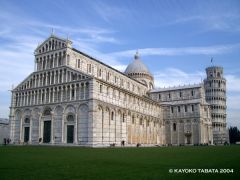
Title: Pisa Cathedral
Date: 1050 (?) Style: Romanesque Artist: Unknown |
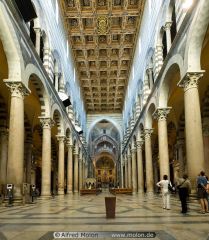
The cathedral reflects the pride and wealth of the Republic of Pisa. Italy was made up of city/states, and they took pride in having the best cathedrals. They won over the Muslims in Palermo Sicily in 1062. They built the cathedral to remember the event.
Pisa has a nave with 2 side aisles, extended transepts, and a Dome over the Crossing Square. It has alternating green and white stone. White=marble, Green= Tufa. It has this pattern all the way up in the interior and exterior. It has three very large PORTALS with roman arches and engaged columns. Above portals on second section and above, it has smaller roman arches and columns with green and white stone. Tower: Has filigree, which is a Gothic addition. It has the cross and a globe, which stood for " Christ over the world, the church over the world". Interior: Looks more Early Christian. Has COFFERED flat roof to take weight off the ceiling. Has clerestory windows, TRIBUNE, and Apse with rounded arches. The side aisles have roman arches with corinthian capital columns. It has STRIATIONS of white MARBLE and green stones TUFA. It also has buon frescos on the walls. On arches leading to the altar shows the scene of ENUNCIATION, when Gabriel gave Mary the news Campanile (The leaning tower)- when it was first being constructed, workers noticed that it began to lean, and realized it was being built by sand. They wanted to demolish it and rebuild it in a different location, but the people didn't want this. They ended up completing it where it was. The 1st register has rounded arches on columns. ABove it are Roman arches on delicate columns. In 1999, the tower was 15ft out of plumb, so it was unsafe for people to tour inside. Large bands were placed all around the tower along with heavy machinery to pull the tower back to its 17th century lean, and created a firmer foundation for it. It is now safe. |
|
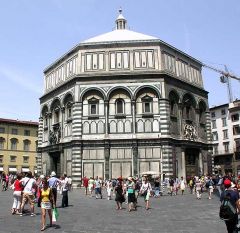
Title: Florence Baptistry
Date:1050 Style: Romanesque Artist: Unknown (?) |
The Baptistry is outside the cathedral. It is in the shape of an octagon. 8 sides stand for:
1. 8 days after Christ's birth, built temple. 2. Christ goes to Jerusalem, 8 days later is resurrected. 3. 8 beatitudes from Matthew's gospels. Each side of the octagon is split up into 3s, which stood for the holy trinity. Bottom part has rectangles, as well as the second section. Second section has rectangles with arches and 3 windows. I has an arch while the other two have triangular PEDIMENTS. Dome: Is also separated into 3s. Striations of white marble and green TUFA create patterns. It is 90 feet. The top has a lantern and a cross above the globe (Christ over the world, church over the world). Famous Doors: Created by Andrea PISANO, and LORENZO GHIBERTI, made of Bronze. It was Lorenzo's whole life. |
|
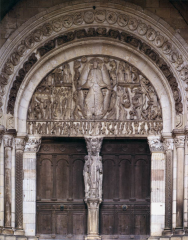
Title: The Church of Saint Lazare - The Last Judgement Tympanum
Date: 1100 (1020-1135) Style: Romanesque Artist: Gislebertus |
This is one of the PORTALS in the WESTERN FASCADE. It is a Post-Lintel construction. The TRUMEAU is the center column, which is a relief sculpture. Above the lintel is the TYMPANUM, which is also a relief sculpture. Surrounding it in half circles, are ARCHIVOLTS. The farthest one has relief sculptures of all the zodiac signs. The people were very superstitious and did things by the stars.
|
|
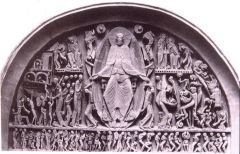
Title: The Church of St. Lazare - Last Judgement Tympanum
Date: 1100 (1020-1135) Style: Romanesque Artist: Gislebertus |
In the center is Jesus. He has a halo on his head inscribed with the cross. He is in a body halo, which is called a MANDORLA. He has his hands out. Wearing fabric/ drapery, where you can get a sense of his arms and knees. It is super abstract.
@ Jesus's Right: Heaven- organized, nice and neat, angels are gathering. @ Jesus's Left: Hell- not organized. In the center is Arch Angel Michael. There are Satin's minions. Skeletal looking, huge mouths, and are all smiling. They have a scale which weighs the souls of the living and the dead in baskets. Michael and the minions are cheating. M is lifting the basket while the minions steal some souls for hell. Humans are whimpering and are lined up on the bottom. There are hands pulling out people from their grave to be judged. Another minion is stuffing a soul into the mouth of hell. Shows terror, tragedy, and is unorganized. |
|

Title: Eve
Date: 1100 (1130) Style: Romanesque Artist: Gislebertus |
Eve is in the lintel above the transept door in the Church of St. Lazare. It is a reminder that you are not the first sinner. Her face has a sense where she shouldn't be doing something, but doing it anyway. Her right has is picking the fruit, while her other hand is calling for Adam. The serpent is on the side plant telling her to eat the fruit.
Legs and Arms- Profile Torso- Frontal. Can see both breasts. Usually, nudity is not allowed during this time, but her lower lady parts are covered with a plant. |
|

Title: Dream of the Magi
Date: 1100 (1130) Style: Romanesque Artist: Gislebertus |
All the capitals of the Church of Saint Lazare were moved into museums.
The base has floral and vine motifs. Above are the 3 kings (magi), and they have crowns on their heads. They are sleeping in bed, when an angel comes down and touches one of their hands with one finger. One magi wakes up and the angel points to the star. Says that the Messiah has been born. |
|

Title: Lions and the Old Testament Prophet
Date: 1100 (1115-1130) Style: Romanesque Artist: Unknown |
This is a lifesize figure, found in the TRUMEAU of St. Pierre in MOISSAC, France. Scholars usually older men who look scholarly, long hair and beards. This is either Jeremiah or Isaiah. The prophet is telling of the coming of the lord. He is looking down. In his hands is his scroll that tells the prophecy of the coming of Jesus. It is a reminder that Christ will soon be here. He is the old testament, holding up the NEW TESTAMENT. He has an abstract pattern drapery, and we get a sense of his body. Crossing his legs, and he looks frail and thin.
On side, 4 lions on top of each other with mouths open. They stand for protection. They are guarding Jeremiah or Isaiah. |
|

Title: The Bayeux Tapestry - Crossing the Channel
Date: 1100 (1070-1080) Style: Romanesque Artist: Unknown Length: 230ft Height: 20in. |
This is an embroidery, which is made out of color thread to create images on fabric, in this case linen. It has 8 different colors of thread. The artists were believed to be women because they needed needles to be super tiny so allow the embroidery. It was hard to do. Embroidery limits the art, so it looks simple.
Secular Art- This artwork has no religious affiliations. Story: Edward the Confessor was the King of England. He made a deal with William of Normandy, saying that after he died, Will would be crowned king. Edward the Confessor died in 1066, but Earl of Wessex was placed on the throne instead. William and the Normands feel betrayed, so they go to war. This Tapestry shows the BATTLE of HASTINGS in 1066. Will and the Normans win the battle, and have a feast at the end. Earl of Wessex was pulled off the throne and William of Normandy was put on it. WIlliam of Normandy's half brother, BISHOP ODO, ordered the Tapestry to be made to detail the Battle of Hastings. 2 Norman boats. They are going to fight the British. Used lines for water. Shows movement with breeze blowing the sails left to right. Boats were bright and colorful. Men in the back boat looked young. Strong outer contour for the face, and inner contour for eyes and lips. Men in the front boat look older. |
|
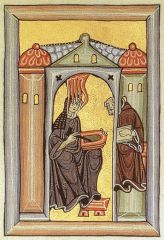
Title: The Vision of Hildegard of Bingen
Date: 1100 (1150-1179) Style: Romanesque Artist: Unknown |
This is a reproduction of the original image.
Hildegard was real. She had visions since she was 8, but did not understand them. When she was 15, she joined the convent and became a nun. Eventually, she became the mother superior of her order in Germany. In 1141, She had a vision of God telling her to tell someone of her visions. She tells Priest Volmer, and he tells her to write down everything in her visions. He believes they are visions of God. She ended up publishing 2 scientific works of the natural world as well as a medical encyclopedia that is still used today. She knows nothing of medicine or natural world. They are all words of God. She is best known for her 77 pieces of music. Page: Structure looks like a Romanesque Church. It has towers, tripedament, domes on towers, and round arch. Hildegard is sitting with her feet on the footstool. The flames are the visions from God into her mind. Volmer is leaning forward and are both writing down her vision. Hildegard is wearing a dark blue habbot with abstract patterning. Volmer's body disappears in his habbot. Perspective of the stool is wrong. Realism not important. The story is. |
|
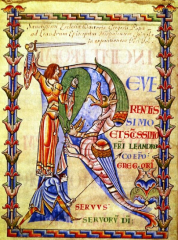
Title: Initial R with Knight Fighting a Dragon
Date: 1100 Style: Romanesque Artist: Unknown |
The artists were cistercian monks. They copied St. Gregory's Moralia about Jobe. St. Gregory the Great was the 4 Latin fathers of church. The Book of Jobe detailed the problem of good and evil. Said that if you don't have God in your life, then its a tough life.
This is the front piece of Illuminated manuscript. It is a letter presented to Bishop Leandro of Seville, Spain. Border: Left and right has stylized floral/ plant motif. Top and bottom is Greek patter ( MEANDER pattern). R: The R tells the story of St. George. Jacobus de Voragine wrote the book, The Golden Legend, which has stories of christ and saints. George is riding a horse in Libya, when he sees a woman dressed in a bride's gown tied up to a rock. She's from the village close by and her father is the mayor. The city is hounded by a dragon. They sacrifice a female virgin for the dragon so it can go away. The mayor chose her. George unties her, finds the dragon, ties it up, and takes them both to the city. He goes to the mayor and makes a deal, saying that if they all convert to Christianity, he will kill the dragon, but if they don't he'll let it go and it will slay them all. They all end up converting and he kills the dragon. Image: George is on top of a squire, wearing tight peach clothing. There are 2 dragons. Squire stabs one with a spear. George cuts off the heads of the dragons. St. George is a very important figure during this time. This image also symbolic of monk's struggle with own spirituality. Have a hard time living by 3 rules: Chastity, obedience, and poverty. |
|
|
Gothic
|
+Religion: Christ is the loving father, seems like ppl have a better chance at getting into heaven.
+Women: Were valued, seen as beauty and love and were written in poems and songs because of the Virgin Mary. She was the Queen of Heaven. Women were valued more. +Gov: Law and order instill confidence in people. Began building universities, cities grew, and new economic force +New middle class- people had more opportunities, could own businesses. +Cathedrals- tall and skeletal looking, with thin walls. - flying buttresses -Gothic pointed arches -Ribbed Groin vaults (all used to take weight off roof, and into the columns towards the ground). -Triforium- fake 2nd story. -had clerestory windows made in stained glass. Usually red or blue. Covered 1/3- 1/2 of walls. - cities and towns fought for the cathedrals b/c 1. It guaranteed people jobs. Economic boom. 2. Attracted tourism. Pilgrims flocked there. Instances: +100 year war- b/t France and England. +The Black Plague- killed 1/3 of European population. +The Great Schism- 3 popes (Pisa, Roome, Augnon) until Mark the V elected to rule. +Giorgio Vasari was the Father of Art History. He was the first to write about art of the Renaissance. |
|
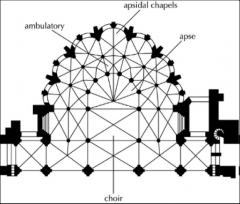
Title: Saint Denis
Date: 1100 (1140-1144) Style: Gothic Artist: Unknown |
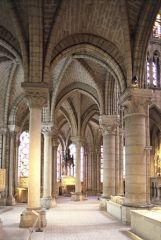
It has an apse, ambulatory, radiating chapels. AM to RC wasn't closed off anymore so people could walk freely.
Abbot Suger saw that the church needed repair, so he build the Western Fascade, then recreated the ambulatory and radiating chapels in the east. He was scholarly and read a lot. He invented the Gothic style by accident. It was born here. Ribbed Groin vaults were heavy and thick. Rested on columns to channel weights from column to the ground. Chapels all have stained glass windows. They were first used here. The light that shone through was called Luck's Nova, The New Light of God. St. Denis brought Christianity to the Gauls. His holy relics were placed here. |
|
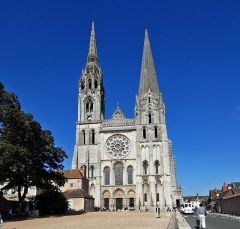
Title: Chartres
Date: 1200 (1134- 1194) Style: Gothic Artist: Unknown |
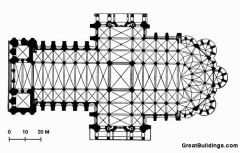
It is located 40 miles SW of Paris, in the city of Chartres.
Interior: It is in the shape of a greek cross. You enter the narthex, has a nave, side aisle, groin vaults, and a transept squeezed in. The crossing square was the unit of measurement for all the church. Has apse, ambulatory, and radiating chapels. It looks tall, but is short for Gothic standards. 120 feet from floor to ceiling. Has TRIPARTITE separation for Nave, triforium, and clerestory windows. Has pointed arches on columns. The clerestory windows, for each bay, it has 2 LANCET windows with 1 circular window on top. It also has RIBBED GROIN VAULTS. Exterior: Tripartite vertically and horizontally. ROYAL portals all have relief sculpture all around it. It has 3 LANCID windows. ALL gothic churches have a ROSE window. It has a rose/ flower pattern and in the center is the Virgin Mary holding baby Christ. It has 12 teardrop shapes around it, which stand for the 12 apostles of Christ. Very little glass, mostly stonework/ ironwork. Above it is a gallery of saints which are all relief sculptures. Towers: Both are different. It is the hardest part of the church to build. -Right: Early Gothic. Has cross and globe, and cutouts for bells. Looks simple - Left: High Gothic. More cutouts, lots of filigree, much taller and thinner, pointed arches, as well as a globe and cross. Interior: |
|
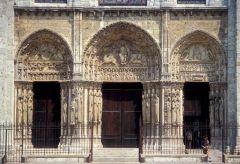
Title: The Royal Portals
Date: 1200 (1145-1155) Style: Gothic Artist: Unknown |
All relief sculpture. Each portal has its own scene.
Left: Christ's death. Center: Christ in Majesty Right: Virgin's Portal- Born Christ. The DOOR JAMBS have the Old Testament kings/ queens/ prophets |
|
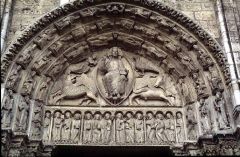
Title: Christ in Majesty
Date: 1200 (1145-1170) Style: Gothic Artist: Unknown |
This is the central portal of the Royal Portals of Chartres. It is located in the Tympanum. It tells of the 2nd coming of Christ. He's in the center with a halo inscribed with a cross, and has a MANDORLA. More realistic here. Get a sense of the body.
The animals around him are the four evangelists: Angel- Matthew Lion: Mark Ox/Bull: Luke Eagle: John Below are people in little round arches. These are the Old Testament Prophets, telling the coming of Jesus. There are 4 sets of 3 people, which symbolize the 12 apostles. Archivolts are from The Book of Revelation. Says that the 24 elders were believed to be a choir of angels. Now they are 12 Old Testament prophets, and 12 New Testament apostles. From the Lintel up is the New Testament. From the Lintel Down is the Old Testament. |
|
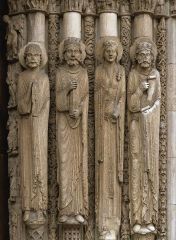
Title: Old Testament Figures
Date: 1200 (1145-1170) Style: Gothic Artist: Unknown |
There are 22 Old Testament Figures in Western Fascade of Queens and Kings, Precursors to Jesus Christ. They lead the way for Christ. They are carved on a round shaft and stand on pedastools.
3 men and 1 woman. All have plate-like halos on their heads. Kings have curly hair and beard. Woman has long braids. Faces look calm and serene. The 2 on the (Right) are holding illuminated manuscripts that tell of the coming of Messiah. The 2 of the left are holding scrolls that also tell of the coming of Christ. Their Drapery falls in a perfect pattern. Looks believable. You get a sense of their body. They look static. |
|

Title: Transept Portal of Chartres
Date: 1200 Style: Gothic Artist: Unknown |
The Church had to be rebuilt due to a fire. It took 27 years to complete. People protested to the Bishop because of the heavy tax load. He ended up running away and hid for 4 years until the people calmed down, then came back.
The portals are really inside. The entire transept is decorated, such as the arches, columns, relief sculptures, and Lancet windows. It is very lavish. The Rose window has much more stained glass. There are a gallery of saints above. |
|
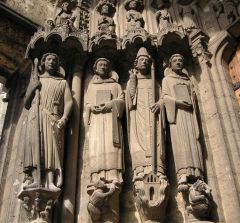
Title: Saints Theodore, Stephen, Clement, and Lawrence
Date: 1200 Style: Gothic Artist: Unknown |
Saints don't seem to be attatched to the columns. They have platelike halos on their heads.
Theodore has short, curly hair. Looks serious. He was a warrior saint. He is holding a spear in his right hand. Wearing a long tunic. Left hand has sword and scabbard. He fights for God. Wearing heavy tights and shoes. He is standing on a pedastool in slight contropposto. Looks very believable. Stephen and Lawrence- Monks. Have a bald circular spot on their heads. Wearing clerical garbs. Holding Illuminated Manuscripts. You get a sense of their arms. Their knees are locked. No sense of legs. Clement- He is the Bishop. He is wearing a Bishop's MITRE (hat). Right hand is doing the sign on blessing. Left hand has a bishop crozier. Wearing a Clerical Garb. Knees are locked. Get a sense of arms. All are standing on decorative pedastools. All look very serious. |
|
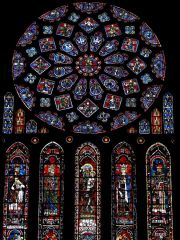
Title: Rose Window
Date: 1200 Style: Gothic Artist: Unknown |
It is mostly small glass. 44 feet in diameter. Mary is holding Christ child in the center. 12 of each shape around. They have Old Testament kings and queens, and patterns. 12 stands for the 12 apostles.
4 leaf clover is the Fleur de Lis. It is the symbol of the French Royal Family. It has the coat of arms of Queen Mother Blanche. She was the mother of King Louis IX. Blanche paid for the Rose window and Lancet. Her coat of arms was put there so we know she paid for it. It memorializes her. |
|
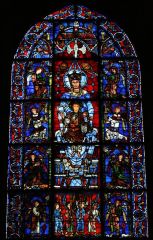
Title: Our Lady of the Beautiful Window
Date: 1170 Style: Gothic Artist: Unknown Size: 16ft X 7ft 8in |
It was originally on the West Fascade as a lancet window. It survived the fire, but it was moved into the apse and enlarged. The center part with red was the older window (12th century). The sides with the blue was the newer glass (13th century). The glass is tinier in the old window, but larger in the new one.
Center: top has a dove that stood for the holy spirit. Shooting rays of blue light. Mary has a halo and a crown, because she is the Queen of Heaven. She only wears the colors blue, red and white. She is holding the Christ Child. He has halo inscribed with a cross. He is wearing red and white. MAking the sign of blessing. He has many tiny pieces of glass.They are surrounded by angels and the old testament prophets. Border: Stylized floral plants. Chartres is the only place with original stained glass. All other stained glass windows were destroyed in WWII. |
|
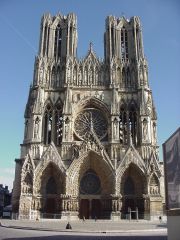
Title: Reims
Date: 1200 Style: Gothic Artist: Unknown |
It is located in Reims, France. It is considered the most beautiful Gothic cathedral in Europe. Every king and queen was crowned there.
It has a narthex, nave, side aisles, clerestory windows (which all create a tripartite separation) transept (much smaller), and a crossing square, which was the unit of measurement. It has apse, ambulatory, and radiating chapels. It has ribbed groin vaults to take weights off roof and walls into the ground. This is the Western Fascade. The eagle inside stands for the evangelist St. John. Front: Tripartite separation horizontally and vertically. Stands for the holy trinity. Portals have stained glass above them. |
|
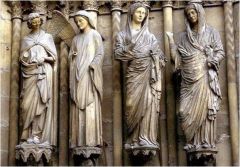
Title: Annunciation and Visitation
Date: 1200 Style: Gothic Artist: Unknown |
Located in the Western Fascade of Reims. Much more realistic.
Extreme Left: The arch angel Gabriel. This is the scene of annunciation. He has short curly hair, and his face looks lifelike. You can see his smile. He is wearing a garment with a cloak held with a broche. He is pulling the garment with his left hand. All the fold look realistic. He is standing in contropposto. You can see his knee and his weight shift. He is standing on a pedestal. He is telling Mary the news that she will be having a baby. Mary: Mantel over hair. Looks calm and serene and is wearing a long garment. You can get a sense of her arms. Her knees are locked (no sense of legs). She is facing Gabriel. Asking him how it is possible for her to have a baby if she is not with a man. Gabriel says that with God, anything is possible. He also tells her that her cousin, Elizabeth, is pregnant. She is much older (in her 50s). Two people on right: Scene of visitation. Mary is on the left and Elizabeth is on the right. They both have mantels over their heads. The fabric falls in beautiful folds. You can get a sense of their bodies. Both of them are pregnant. Both are standing in contropposto. Elizabeth's baby is John the Baptist. He paves the way for Jesus. These are door JAMBS. They are free-standing from the columns. 3 artist created this piece. 1. Gabriel- Great sense of emotion and realism. 2. Mary- not as good. No sense of knees. 3. Pregnant Mary and Elizabeth- same style, good technique. |
|
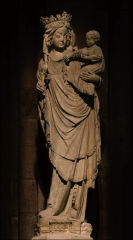
Title: The Virgin of Paris
Date: 1300 Style: Gothic Artist: Unknown |
This is Madonna portrayed as Theotokos, which means the Mother of God. There was a council to discuss whether Mary was mother of just the human christ, or of the deity. It was declared that she was the mother of God.
She is wearing a crown because she is the queen of heaven. She is holding the christ child in her left arm. She is leaning into her arm to support the weight. She has a sway in her body. Jesus: Curly hair, wearing drapery, holding the world in his hands. He doesn't look like a baby. Her right hand is carrying a lily, which stands for her virginity/ purity. She is standing on a base. This is located in the Notre Dame in Paris, France. You get a sense of love and bond. |
|

Title: The Virgin of Jeanne d'evreux
Date: 1300 Style: Gothic Artist: Unknown Media: Silvergilt (Made of silver, gilded in gold) |
Jeanne d'Evreux was the queen and wife of King Charles IV. She donated this reliquary to St. Denis in 1339. Reliquaries hold holy relics. This relic holds a single strand of the Virgin Mary's hair.
Mary has a mantel over her head. She is the queen of heaven. Looks calm and serene. Leaning into baby to support weight. Has a sway to her. Jesus: In her left arm. Reaching towards Mary. Holding the world in his left hand. Both are wrapped in drapery. Looks very realistic. Right hand: Has a sector in the shape of a Fleur de lis. Symbol of the French Monarchy. This is where the hair of the Virgin Mary is located. Below: Box, has columns and figures that are believed to be Old Testament prophets and saints. It has pointed arches. In between are paintings of the Passion of Christ. They are a reminder that you are praying to God, not Mary. |

